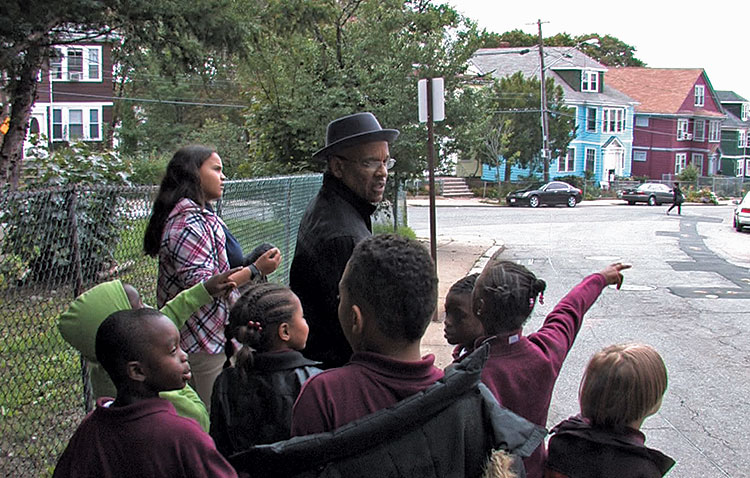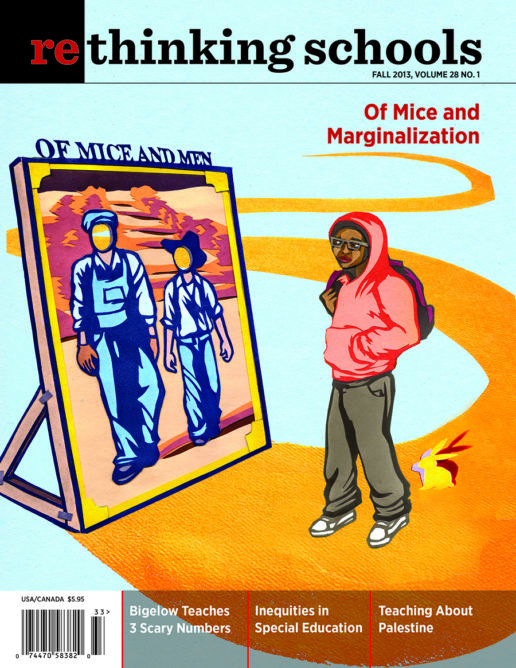Schools That Change Communities

Schools That Change Communities, Bob Gliner’s 2012 film, provides a view of what we should be aspiring to in schools. Let’s call it aspiring to high standards within the context of respecting the whole child and grounding education in place and community.
Gliner has made a number of previous films that illustrate healthy, balanced approaches to education. In Lessons from the Real World, he illustrates approaches to reading, math, and other subjects in which students care about what they are learning because the subject matter relates to their real lives. In Democracy Left Behind, he “examines the impact of No Child Left Behind on the ability of schools to serve a civic missionÑdemonstrating how difficult it is now for many students to understand what their education means in the larger context of the society and world they inhabit.” Gliner’s films aren’t slickly produced, but they have a lot of heart. And their somewhat homegrown quality is reflective of the value of grassroots, uniquely crafted, educational solutions to the problems of American schools.
Schools That Change Communities focuses on five schools in five very different communities across the United States. The diversity of grade levels and ethnic profiles shows that this kind of innovative, place-based approach can work anywhere. All are public schools, three out of five in high-poverty areas.
In the opening segment at Young Achievers Math and Science Pilot School in Boston, we hear the children chanting: “I have the power. You have the power. We have the power.” This focus on community activism and engagement is a crucial part of the Young Achievers ethos. In KIPP schools, you’ll see lots of chanting as well, but that chanting is often of the multiplication tables rather than about empowerment and civic engagement. At Young Achievers and the other schools in this film, the emphasis is on connecting the curriculum to real issues and problems in the school and the community. The teachers create curriculum that changes students and changes communities. Greg Smith of Lewis & Clark College explains that this grounding of curriculum in the natural and social context is what makes education relevant and meaningful: “These kids don’t need to ask ‘Why am I learning this?’ They know why they’re learning it.”
We see the students at Young Achievers working with Jos Mass, a grandparent and WBUR (Boston’s National Public Radio) radio show host, to produce public service announcements about asthma. The realness of the work is compelling. Students know that they’re not just doing this for the teacher, they’re doing this for the community. Mass summarizes:
From an early age, they understand the idea of civic engagementÑnot to be bystanders, but to be active in changing things they believe need to be changed. That has to be part of the pedagogy in schooling if we’re going to be successful in the 21st century. It empowers them to believe and know when they share their learning with a wider audience.
Bo Hoppin, the experiential education coordinator, articulates the rationale behind the 1st-grade farm-to-table curriculum. After numerous field trips to an apple orchard, a local farm, and nearby gardens, the students write a book about farm systems. Different student groups each write a chapter about the orchard, milk production, and bees. Hoppin explains:
That all adds up to a really nice literacy component that gets kids interested in reading and writing because they’ve been to the farms and eaten the foods, and they’re motivated to produce a high-quality big book. More importantly, that big book becomes the most-read book in the classroom.
As Young Achievers’ students move up through the grades, this connectedness between the curriculum and action in the community matures. Academic achievement and learning to be a responsible citizen go hand in hand.
Crellin Elementary is a K-5 school in western Maryland coal mining country. When acid mine drainage is identified on a site adjacent to the school, the faculty work with the Bureau of Mines to mitigate the polluted water and create an environmental education laboratory for the schools. The project makes for great curriculum and for improved water quality in adjacent Snowy Creek.
Skeptics, of course, wonder whether this approach will sacrifice student achievement and depress test scores. For example, Crellin 4th and 5th graders are engaged in a Trout in the Classroom project. If children are taking field trips to the stream to do water quality testing to make sure the water is healthy for trout, are they sacrificing time from literacy or math? Gliner addresses this issue in the film. There’s joyful footage of transferring the trout from the classroom to the local stream with smiling students, helpful parents, and the Department of Natural Resources specialist. Then, back in the classroom, the principal leads a related math lesson. This is when math comes alive, when it’s directly related to real-world experiences. In 2010, Crellin was rated the highest performing elementary school in Maryland.
The last segment in the film focuses on Watsonville High School in California. Watsonville is a farming community, known for its extensive berry fields and for its 25 percent unemployment rate. Several interdisciplinary academies have been created at the high school in an attempt to more deeply engage students. The Video Academy integrates English, social studies, science, and video production with a focus on community problems. A teacher introduces a project by describing how they’re going to look at the issues of the Great Depression and then use that lens to focus on the problems of Watsonville and figure out how to create a New Deal for their community. The issues in Watsonville are big – high unemployment, undocumented workers, immigration raids, homelessness.
In the beginning, the mostly Latina/o students look skeptical and disaffected. But as they identify the causes of unemployment, practice interviewing, and articulate the problems facing immigrants, the students come alive. They head out into the community to interview and film farm managers, agricultural workers (with their faces blurred to protect their identities), the immigration program director, the mayor, the food bank manager, and lawyers at the Watsonville Law Center. Some of the students explore gang violence and its origins. It’s all done in Spanish and it feels edgy as the students probe tough and gritty issues. Gliner ends this section of the film with students reflecting on how the experience changed their understanding of learning. According to one student:
It actually lets us see the community’s true colors. Rather than just hearing about a problem, letting it go in one ear and come out the other, we actually get it into our heads that there is a problem here. We need to address it and we need to fix it.
There are innumerable other great moments in this film. I particularly appreciate the interviews with parents, who talk about how the schools are making a difference in the lives of their children and in the lives of their communities. These are parents who’ve seen their students vibrantly engaged in learning and recognize that school is about more than just increasing test scores. One of the parents at Young Achievers says:
The school has helped change parents’ paradigms and their perspectives on who they are, who their kids are, and what their community is all about. But most importantly it’s changing the kids’ paradigms. . . . The kids are dreaming again.

